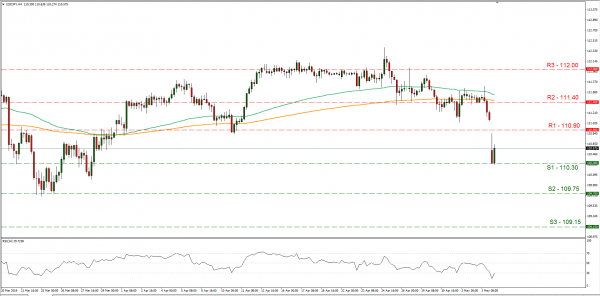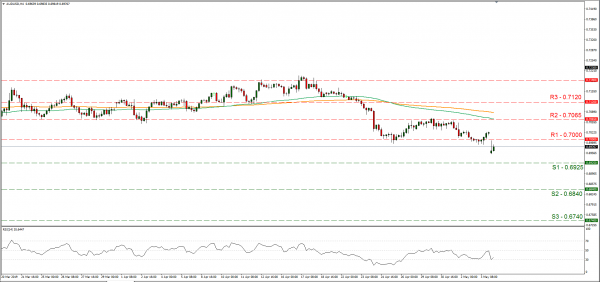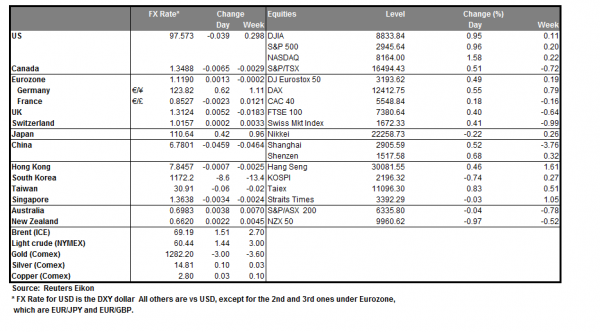Yesterday, US President Trump threatened to hike tariffs on Chinese imports, raising tariffs from 10% to 25%. The US President, mounted pressure on China, as he considered that the US-Sino trade talks were moving too slowly. The tweets were regarded as a major shift from the US President’s prior position, were he saw good progress in the negotiations. Media also reported that China considers cancelling Wednesday’s negotiations in Washington. It remains to be seen whether the move is part of a negotiating tactic or if US president Trump is to follow through on his threats. In any case Trump’s tweets definitely escalated the situation and the markets reacted accordingly. The development strengthened JPY which is considered as a safe haven, while at the same time plunged the AUD which is considered a close proxy to the Chinese yuan. USD/JPY opened with a negative gap during today’s Asian session below the 110.90 (R1) support line (now turned to resistance), as the Yen strengthened by the developments. We could see the pair maintaining a wait and see position and we expect it to be sensitive to any further headlines regarding the US-Sino negotiations. Should there be further escalation we could see the JPY strengthening even further. If the pair comes under the selling interest of the market, it could break below the 110.30 (S1) support line and aim for the 109.75 (S2) support barrier. On the other hand, if there are buying orders, it could break the 110.90 (R1) resistance line, aiming for the 111.40 (R2) resistance level.
RBA’s Interest rate decision
Tomorrow during the Asian session (04:30, GMT), RBA is to announce its interest rate decision. The bank is expected to remain on hold at +1.50% and currently the AUDOIS imply a probability of 60.81% of such a scenario. Should the bank remain on hold, we could see the market’s attention turning to the accompanying statement. Given the current situation and weak Australian financial data, as well as the recent deterioration of the US-Sino relationships, we could see a dovish tone prevailing in the bank’s accompanying statement. If the bank proceeds with a rate cut or maintains a dovish tone in its accompanying statement we could see the AUD weakening even further. AUD/USD dropped during today’s Asian session as the AUD weakened due to Trump’s threats, breaking below the 0.7000 (R1) support line (now turned to resistance). We could see the pair maintaining some bearish tendencies given to the recent developments, as well as in anticipation of the bank’s interest rate decision. Should the bears take over the pair’s direction, we could see it breaking the 0.6925 (S1) support line and aim for the 0.6840 (S2) support hurdle. Should the bulls dictate the pair’s direction, we could see it breaking above the 0.7000 (R1) resistance line and aim for the 0.7065 (R2) resistance level.
Other economic highlights, today and early tomorrow
In the European morning, we get from Germany’s final Services PMI for April and during tomorrow’s Asian session we get Australia’s retail sales growth rate and trade balance figure both for March. As for speakers, please note that the Philadelphia Fed President Harker and BoC governor Poloz are speaking today.
As for the rest of the week:
On Tuesday, we get from Germany March’s factory orders growth rate and from the UK the Halifax house prices for March. On Wednesday, we get the RBNZ’s interest rate decision along with China’s Trade Balance for April. On Thursday, we get the China’s CPI rates, the US PPI rates for April, and Canada’s Trade balance March. On Friday, we get the UK GDP for Q1 and the US CPI rates for April.
Support: 110.30 (S1), 109.75 (S2), 109.15 (S3)
Resistance: 110.90 (R1), 111.40 (R2), 112.00 (R3)
Support: 0.6925 (S1), 0.6840 (S2), 0.6740 (S3)
Resistance: 0.7000 (R1), 0.7065 (R2), 0.7120 (R3)

















